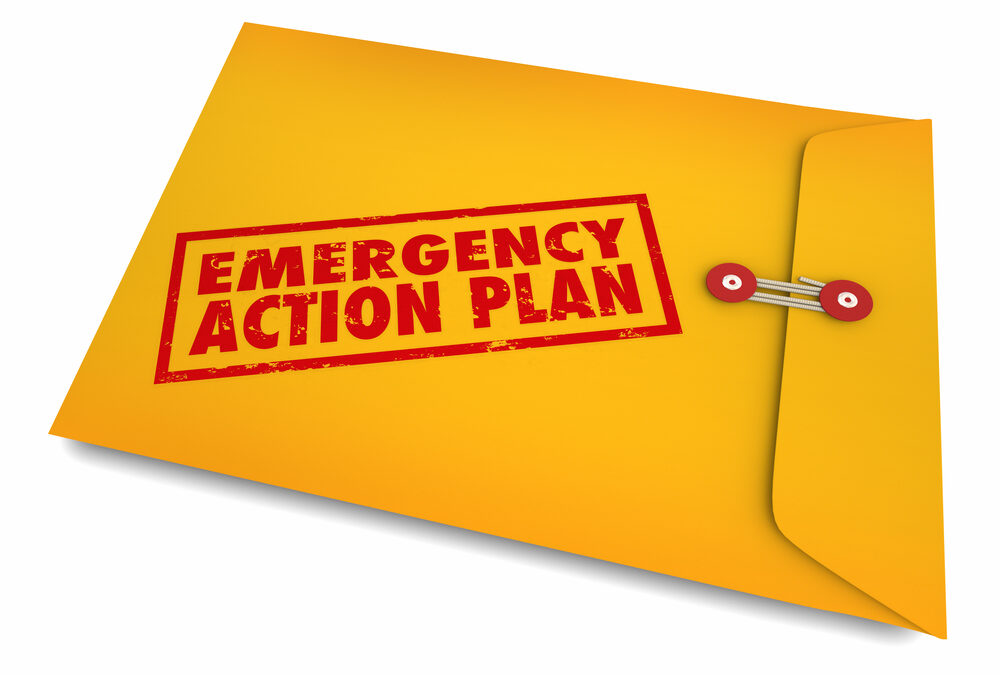Is your company prepared for an emergency? Whether in an office environment, a construction site, or a manufacturing facility, OSHA requires you to plan how to handle emergencies. Here are the key components you need to consider as you create and implement an Emergency Action Plan for your organization.
Creating and implementing an Emergency Action Plan does not need to be complex or time-consuming to be effective. Without an Emergency Action Plan, no one is fully prepared to respond to unforeseen workplace emergencies.
Here are ten steps to create an Emergency Action Plan (EAP) to ensure the highest safety and survival in an emergency.
- Create an Emergency Response Team (ERT) An ERT should have team members from all organizational levels to ensure buy-in throughout the workforce. This coordination is the first crucial step to ensure your EAP is effective and efficient in minimizing injuries and illness and possibly preventing fatalities.
- Recognize and Assess Potential Emergencies What hazards do we have or can we create in our facility and specific work areas? Examples include fires, First Aid/CPR, Tornadoes, Floods, Hurricanes, and Accidental Releases of Hazardous Chemicals.
- Develop Clear and Effective Emergency Procedures Your procedures should outline actions to take during different emergency scenarios. In an emergency, what protocol should be used to ensure everyone’s safety? Examples include who the first responders are, where the evacuation meet points are, what to do in the event of an explosion, etc.
- Complete Emergency Equipment Identification and Location Ensure emergency equipment is readily accessible and well-marked. This includes first aid kits, fire extinguishers, defibrillators, and more. The goal is to guarantee that all personnel can access emergency equipment and know where to find it. Examples include designated fire extinguisher locations/signs, first-aid kits, etc.
- Conduct Emergency Equipment Training Properly train employees using emergency equipment like fire extinguishers and automated external defibrillators (AEDs) and provide first aid and CPR. OSHA requires you to train employees on using fire extinguishers or providing First-Aid/CPR. Examples include fire extinguisher PASS (Pull pin, Aim, Squeeze, Sweep), First aid/CPR/AED certifications that expire after two years, etc.
- Identify Location and Contact for External Emergency Facilities Be sure employees know how to contact external emergency facilities, such as fire stations or medical facilities if needed. Examples include the nearest fire station, medical facilities, police station, etc.
- Establish Alarm And Emergency Communication Requirements Establish a system to notify employees and designated personnel to ensure a prompt response. Examples include a central alarm system, radio communication, designated personnel to inform employees, etc.
- Document and Communicate Procedures For Rescue And Evacuation Create and communicate a clear plan for conducting rescues and evacuations, including Designated Emergency Assembly (DEA) locations, to minimize confusion and maximize safety. Include details such as how and who will conduct rescue, where everyone is to collect, and who is to conduct a head count, whether indoors or outdoors. Examples include maps for Designated Emergency Assembly (DEA) locations, assigned first-aid responsibilities, etc.
- Assign Emergency Contacts Identify who should be notified in an emergency to ensure key internal individuals are informed promptly. Your EAP should have the person’s full name, title, and phone number for each emergency contact. Examples include the Safety Manager, Supervisors, Foreman, etc.
- Complete Periodic Practice Drills Conduct emergency practice exercises and assess outcomes, noting where improvements need improvement.
Once you recruit an Emergency Response Team, they can use this list of steps as a guide to ensure the successful development of each step and reduce complexity. The team will significantly minimize the time consumed by creating EAPs and have a direct understanding of the importance they all played in this program. This communication can create comradery, synchronicity, and pride in your company’s Emergency Action Plan.
The effectiveness of the Emergency Action Plan will come from the unity created by the Emergency Response Team and the buy-in from all employees while they are educated. The importance of each element in all emergencies should be vital to enriching them with a sense of responsibility. Supervisor and management’s positivity toward the development, implementation, and execution of all Emergency Action Plans will only spell “SUCCESS.”
“Hoping for the best, prepared for the worst, and unsurprised by anything in between.”
-Maya Angelou




